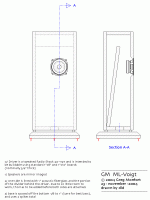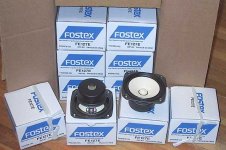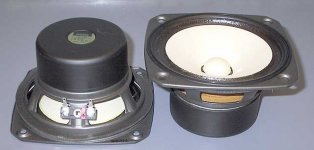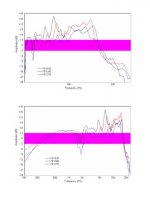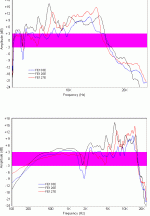planet10 said:Something like this? I choose xSection breakdown based on minWidth and added a bit of a base... driver mounted on slantSide to keep minimum height....
dave
Pretty short huh? I like the base. Nice touch! It could be easily folded too.
Timn8ter said:It could be easily folded too.
It would... make a nice compact stand-mounter -- and facilitate a nice bi-pole too
dave
planet10 said:
It would... make a nice compact stand-mounter -- and facilitate a nice bi-pole too
dave
Exactly what I was thinking. BTW, you nailed that drawing. Just like it came out of head and magically appeared in myriad little dots.
planet10 said:
It would... make a nice compact stand-mounter -- and facilitate a nice bi-pole too
dave
The vent/base design looks awfully familiar.
GM
GM said:The vent/base design looks awfully familiar.FYI, the 126 with ~5 ohms (whatever gets Qts to ~0.403) looks great in those folded 40-1197 pipes, with 8 ohms yielding ~the same response/BSC compensation.
It -- or the BD-pipes i've been living with -- inspired the port & bass. The 3 points are definitly inspired by your design.
A lite version of GMs pipe attached. He has donated the design to the transmission line speakers site with the intention that plans will be distributed on a "by donation" basis... even without having the page up or the details of distribution worked out i've already had one donation of $25 for the plans.
dave
Attachments
Makes perfect sense but kinda odd that it´s not seen more often then.In the absense of another driver to actively cancel newtonian motion, this scheme ties the driver better to the mass of the cabinet and minimizes it. A more elaborate scheme actually has a tightening mechanism so that you can dial in the amount of pressure on the driver.
Thought it may be freeware.VectorWorks. May not fit into your budget, but despite some serious horsepower & feature set, is very simple to use for these kinds of drawings.
Once i have the drawing done, i just get the size i want on the screen, use the OS X built-in screen snap and take the resulting pdf into PhotoShop to tweak it and save out as a gif file.

Thanks a lot anyway.
Well, in the 'good old days', the average driver was made much more robust, with more lossy gaskets and bolted into more rigid cabs with more mounting points than the norm today, so there wasn't as much need for it. Plus, with greater average efficiency, lower excursion due to limited LF BW and much more noise in the signal to mask any driver generated noise....... And of course today it's often a matter of paring parts/assembly costs to the minimum.Makes perfect sense but kinda odd that it´s not seen more often then.
Anyway, the better drivers of today don't need it. For instance, as a default note for all my designs, I recommended using the screw adjustment on the various Jordan, Fostex, etc., ones, but AFAIK only two folks did it (JX92S, FX200) and neither found any audible difference, and prosound quality drivers are still sturdily built so only needs to be supported if required to survive the abuse of repeated shipment.
On a 'flimsy' driver or one with a hard paper gasket though, the difference isn't subtle.....
GM
thanks GM for your insight!
do you happen to have written a book about these things?
PS.: I always wanted to start a thread about one of your designs which is working great for me but am still tweaking (active-XO) as the woofer is only almost fullrange so I just stuck a TB somehwere into the enclosure.
So thanks once more to you and MJK.
Gradient TL+TB (132kB)
do you happen to have written a book about these things?
PS.: I always wanted to start a thread about one of your designs which is working great for me but am still tweaking (active-XO) as the woofer is only almost fullrange so I just stuck a TB somehwere into the enclosure.
So thanks once more to you and MJK.
Gradient TL+TB (132kB)
You're welcome! No, not much point in it since everything I've learned is in one book or another. Anyway, Earl Geddes has strongly implied that if it's not in his book it's not relevant to speaker design/application, so maybe it's worth the semi-high price.
BTW, you did seal up the back of the TB, making it basically a wide BW sealed back tweeter so that the woofer/pipe action can't modulate it, right?
GM
BTW, you did seal up the back of the TB, making it basically a wide BW sealed back tweeter so that the woofer/pipe action can't modulate it, right?
GM
Well, it was a very spontaneous and naive newbie-act when I put in the TB. Took me a while to realize I should best seal it off.
XO is 12dB-LR-active at 340Hz at the moment so the TB would need at least 1,5l (91.5 in^3) to stay linear to that point.
This volume in a relatively thin pipe (324cm^2 or 50in^2) is an interruption in the line and probably worse than some modulation?
I´m already thinking about using another fr-driver that only needs 40in^2 so that might be my ticket.
Maybe I´ll end up with a much higher XO-point anyway; who knows...
Sorry for OT
XO is 12dB-LR-active at 340Hz at the moment so the TB would need at least 1,5l (91.5 in^3) to stay linear to that point.
This volume in a relatively thin pipe (324cm^2 or 50in^2) is an interruption in the line and probably worse than some modulation?
I´m already thinking about using another fr-driver that only needs 40in^2 so that might be my ticket.
Maybe I´ll end up with a much higher XO-point anyway; who knows...
Sorry for OT
planet10 said:
Very nice. I have 4 on the way. I'm looking forward to using them with my new tube amp.
Happy New Year,
Gio.
Happy New Year to all,
Tim Forman was the forum member supplying the FE127E driver. Thanks Tim. The FE127E driver arrived Monday afternoon, January 3, 2005. I have completed a comparison test series on the three drivers (FE103E, FE126E, and FE127E). I used a test bed I have talked about before. It was design to eliminate as many extraneous variables as possible. This is also a test bed with a substitutable driver mounting baffle system. This allowed me to swap drivers while holding all geometric arrangements constant between driver and microphone with a high degree of precision. In addition, driver levels and microphone gain were held constant across all tests.
There are a couple of items I want to mention before I post the comparison response attachment.
First, the phenomenon of psychoacoustics plays a part in evaluating drivers with music by ear alone. One psychoacoustic’s phenomena is how the ear/brain tries to compensate for large spurious vibration modes. Our ability to hear error in reproduced music decreases when the errors are extremely large. As the reproduced music comes closer to being error free, our ability to hear small errors increases. This produces a tendency to underestimate just how bad a really bad driver may be.
Second, the look of the graphs has changed since my last post. I am using a different analyzer system as a backup. Between December 22 when I last powered down the acoustic analyzer and December 27 when I powered back up, there had been a hardware failure in the front end/AD portion of the analyzer system. It is not going to be an easy or quick repair (even if it is repairable).
Until the main system is repaired, I will be using the backup (a portable system). I have done extensive work to validate the results from the backup system.
For now, to the limit of the extremely small sample size, the tests I post here are of an acceptable level of accuracy and resolution. While I post the first of the tests without comment, there is much we can talk about the performance of the three drivers.
Good designing and good building,
Mark
Tim Forman was the forum member supplying the FE127E driver. Thanks Tim. The FE127E driver arrived Monday afternoon, January 3, 2005. I have completed a comparison test series on the three drivers (FE103E, FE126E, and FE127E). I used a test bed I have talked about before. It was design to eliminate as many extraneous variables as possible. This is also a test bed with a substitutable driver mounting baffle system. This allowed me to swap drivers while holding all geometric arrangements constant between driver and microphone with a high degree of precision. In addition, driver levels and microphone gain were held constant across all tests.
There are a couple of items I want to mention before I post the comparison response attachment.
First, the phenomenon of psychoacoustics plays a part in evaluating drivers with music by ear alone. One psychoacoustic’s phenomena is how the ear/brain tries to compensate for large spurious vibration modes. Our ability to hear error in reproduced music decreases when the errors are extremely large. As the reproduced music comes closer to being error free, our ability to hear small errors increases. This produces a tendency to underestimate just how bad a really bad driver may be.
Second, the look of the graphs has changed since my last post. I am using a different analyzer system as a backup. Between December 22 when I last powered down the acoustic analyzer and December 27 when I powered back up, there had been a hardware failure in the front end/AD portion of the analyzer system. It is not going to be an easy or quick repair (even if it is repairable).
Until the main system is repaired, I will be using the backup (a portable system). I have done extensive work to validate the results from the backup system.
For now, to the limit of the extremely small sample size, the tests I post here are of an acceptable level of accuracy and resolution. While I post the first of the tests without comment, there is much we can talk about the performance of the three drivers.
Good designing and good building,
Mark
Attachments
I am posting a second attachment that should be easier to read.
Really better, thanks.
Considering the curves don't you prefer the FE126E now ?
- Home
- Loudspeakers
- Full Range
- diyAudio Full Range Reference Project
